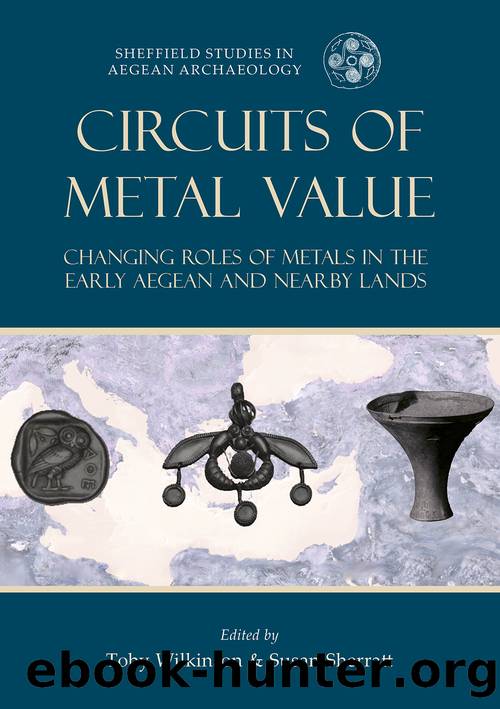Circuits of Metal Value by Toby C. Wilkinson;Susan Sherratt;

Author:Toby C. Wilkinson;Susan Sherratt;
Language: eng
Format: epub
ISBN: 9781789259629
Publisher: Casemate Publishers & Book Distributors, LLC
Published: 2023-06-15T00:00:00+00:00
Chapter 5
The development of ironworking in the 12th and 11th centuries in Cyprus
Joanna Palermo
The iron industry in Cyprus was virtually non-existent until 1200 BC when the number of iron artefacts increased so dramatically and abundantly that Cyprus is identified as one of the first regions in the eastern Mediterranean to develop ironworking. Studies focusing on the economic benefits of exporting iron as well as metallographic analyses aimed at understanding the production methods have provided a great deal of insight into this phenomenon. This study provides an additional perspective by focusing on the context of the objects, particularly the large group of iron knives that make up the bulk of the iron corpus in Cyprus. Iron in this period is often thought to derive value from its scarcity, but the large-scale production, the standardisation, and the unusual variety of find contexts suggest that these knives appealed to a local rather than export market, and that their value derived from something other than the rarity of the material.
Although the scale of ironworking increased across the eastern Mediterranean at the end of the Bronze Age, any attempt to develop a pan-Mediterranean model to account for this phenomenon struggles to encapsulate the nuances of development in each region. Iron working in Cyprus, for example, arose under circumstances that made it stand out from its neighbours. First, unlike most Mediterranean regions, iron, particularly in the form of ornamental and prestigious funerary items, was completely absent from the island in the Bronze Age. Second, Cyprus developed its own unique technique for deriving iron resources as a by-product of copper smelting rather than directly from the ore. These factors set Cypriot iron use on a unique trajectory, one that reflects a series of local choices made during industrial production by those involved in the metal industry, as well as deposition choices by consumers of iron items. We tend to think of such choices in terms of the chaîne opératoire; that is, a series of decisions that pervade the entire metallurgical process from ore prospection to artefact production (Rehren and Pernicka 2008: 234). This paper focuses on three aspects of this decision-making process. The first are the choices that miners and craftsmen made that allowed ironworking to flourish alongside and not in competition with the islandâs prominent copper industry. The second set of choices are those that smiths made regarding which types of objects to adapt to iron. In Cyprus, the local production of iron entailed the wholesale development of new classes of objects adapted primarily from Aegean and Levantine bronze models. The final aspect to consider, although not traditionally part of the chaîne opératoire, is how the consumers chose to use and deposit the items, which entails a review of their find contexts, including settlement and funerary depositions. By focusing on the factors unique to Cyprus, this paper aims to understand the nuances of the regionâs burgeoning iron industry.
I. The copper and iron industries
The factors that define the development of ironworking in Cyprus in the 12th century
Download
This site does not store any files on its server. We only index and link to content provided by other sites. Please contact the content providers to delete copyright contents if any and email us, we'll remove relevant links or contents immediately.
The Daily Stoic by Holiday Ryan & Hanselman Stephen(3158)
The Fate of Rome: Climate, Disease, and the End of an Empire (The Princeton History of the Ancient World) by Kyle Harper(2932)
People of the Earth: An Introduction to World Prehistory by Dr. Brian Fagan & Nadia Durrani(2647)
Ancient Worlds by Michael Scott(2541)
Babylon's Ark by Lawrence Anthony(2465)
Foreign Devils on the Silk Road: The Search for the Lost Treasures of Central Asia by Peter Hopkirk(2396)
The Daily Stoic by Ryan Holiday & Stephen Hanselman(2391)
India's Ancient Past by R.S. Sharma(2335)
MOSES THE EGYPTIAN by Jan Assmann(2313)
The Complete Dead Sea Scrolls in English (7th Edition) (Penguin Classics) by Geza Vermes(2175)
Lost Technologies of Ancient Egypt by Christopher Dunn(2148)
The Earth Chronicles Handbook by Zecharia Sitchin(2123)
24 Hours in Ancient Rome by Philip Matyszak(1997)
Alexander the Great by Philip Freeman(1987)
Aztec by Gary Jennings(1901)
The Nine Waves of Creation by Carl Johan Calleman(1812)
Curse Tablets and Binding Spells from the Ancient World by Gager John G.;(1792)
Before Atlantis by Frank Joseph(1761)
Earthmare: The Lost Book of Wars by Cergat(1737)
